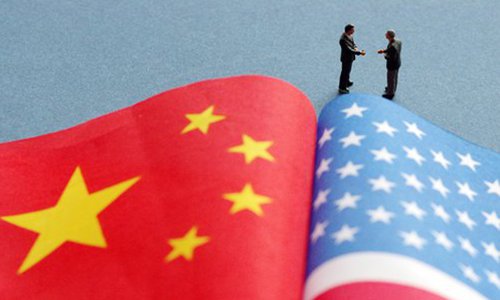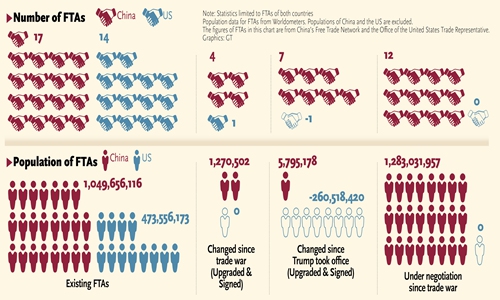
Chinese and US trade officials make attempt at striking a trade deal to defuse an increasingly bruising trade war that has rattled global markets and presented mounting challenges to both economies. Photo: VCG

Graphics: GT
Among the year-long trade war between China and the US, China's free trade partners have been gradually increasing while those of the US have remained the same, according to data gathered by the Global Times from each country's official trade websites.
Data from the websites show that as of November 2019, China has signed 17 Free Trade Agreements (FTAs) with 25 countries while the US has 14 FTAs with 20 countries, which simply means Chinese products could reach the total population of as many as 1.05 billion, with the US sitting at 473.6 million.
Since US President Donald Trump took office in 2017, the number of FTAs dropped from 15 to 14. Trump advocates trade protectionism and unilateralism under the slogan "America first," and he also withdrew the country from the Trans-Pacific Partnership (TPP).
The population that US products can reach without tariffs dropped 260 million (countries that already have FTAs with the US are excluded) as the US exited the 12-nation pact.
According to the Office of US Trade Representative's reports, since 2017, despite several trade talks with such countries as Japan, the UK and, of course, China, the US has only signed one FTA with Canada and Mexico - the USMCA - a modified version of NAFTA per Trump's request.
Meanwhile, as China is further opening-up, the country has speeded up moves to extend its free trade connections. According to the China Free Trade Network, China has signed or upgraded seven FTAs since 2017, which includes three new deals with countries including Georgia and the Maldives and four upgraded FTAs with countries including ASEAN countries and Chile.
There are still 12 free trade deals under negotiation or in the pipeline, including the Regional Comprehensive Economic Partnership, which, if signed, will extend the populations of signatories with China to 2.33 billion - nearly one-third of the total population of the world.


